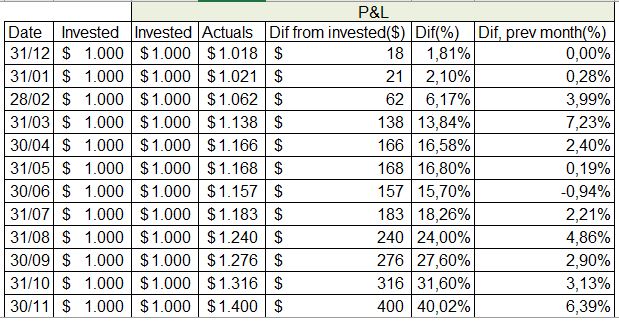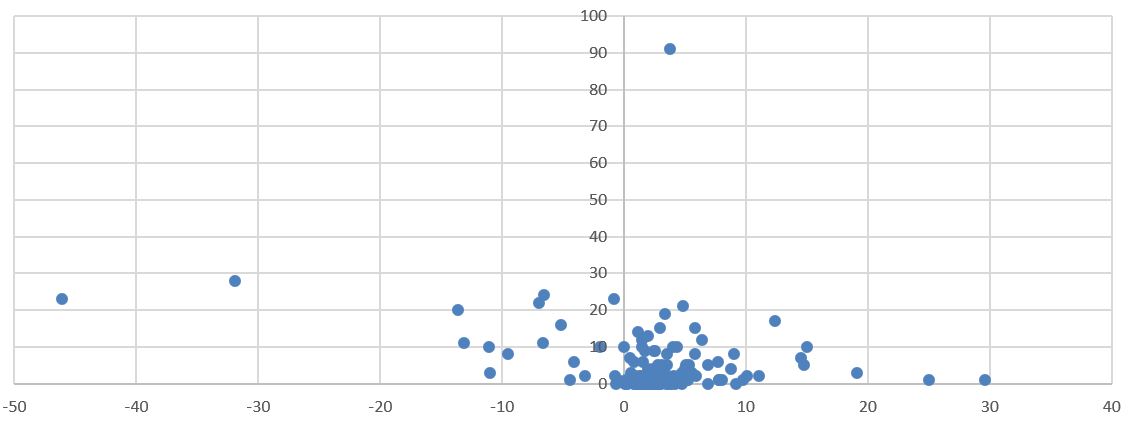In 2018, I created a Robinhood account and I added 1000$. I had a goal, it was to trade with that money, and learn about how to trade in a systematic way and understand how the environment was going on.
I started slowly, with few amount of moves, practicing on stocks I knew and using the learning I acquired trading with crypto-currencies (year 1).
As the money was limited, I divided the trades in 4 units, so every long event should be around 250$. My initial goal was to obtain a 6% growth through 2019.
I did not want to limit myself to a goal number, as the market would have a direction that I cannot control in 12 months, but I wanted to set a reference and initially it was 6%, then I moved to 10%, then I moved to 25%.
The math result? I did a 40%
This final result was an unexpected result, I started doing individual moves and learning from my previous experience, understanding the SPX behavior and trying to learn from the results. Initially I was psychologically stressed with the situation, but I learned how to handle it and the results started to be positive once I keep the actions aligned to my convictions.
The learning result?
I have learned a lot of things, as in the middle of the process I had no money to trade, or I had problems to be with time in front of the computer, or there were times where the market was not in the conditions I defined to trade. Some of the things I learned:
- To be as much systematic as possible:
- defining a set of environmental factors that I checked before to trade.
- I have defined a set of companies that I use for trading, depending on different conditions.
- I have been able (not 100% of times) to close the computer and read a book when the conditions where not the right ones.
- I started to be more systematic after reading Systematic trading 🙂
- Analysis:
- Analysis of companies, about how they generate cash-flow, in which part of the cycle they are, etc.
- I learned how to follow trends (differentiate when market is pushing or is moved by inertia).
- I learned to focus on quote ranges, not on trends. There is a space where the market is moving, I have tried to focus on that range of realistic moves, focusing on small trades.
- Act aligned to my convictions, and recognize that I have to be flexible about convictions:
- I have learned a lot about how bad I am about this. I need to improve a lot if I really want to be successful. To trade with 1000$ is nuts, and when the number will increase I have to be more mature on this area. Let’s say that I am more aware of my problem with early shorts that could gave me bigger returns.
- I learned that I am mainly a negative skew trader. The good thing is that now I’m aware of that and I’m adding some actions on my habit at the time of adding stop-loss actions.
- I have to improve better to short on loses before the lose is too high. I have earned an average of 2,32$ per trade, if I remove the 10% of biggest loses I would have obtained an average of 3,78% which is a lot.
- The thesis I have done have changed with respect the environmental conditions that have been happening. I have used the China-US trade news, brexit, Brent price and euro/dollar exchange as variables to modify my thesis and market behavior.
- You are managing a portfolio of money, and you have to be consequent with the limits of resources:
- Sometimes I had no money to trade, when the market was in the best moment to short.
- I learned to anticipate to the best moments and short some moves with the purpose of doing small margins but have cash for next days.
- During the last 2 months I was able to do 5 units, as I was over 1200$, so I could trade a little bit more.
Analysis of data
 I have done 157 trades during these 12 months.
I have done 157 trades during these 12 months.
- 20 trades were below zero (loses), 137 were over zero (gains).
- The worst 10% of the trades supposed me to lose 173$. If I would have stopped these loses before I would have earned more. I have to take into account too that the use of stop-loss in the wrong way would have made me to lose some margin on trades that I have finally be over zero.
- Using pareto principle (six sigma), where solving 20% of the issues you can solve 80% of the consequences, I have added to my habits:
- Stop losses in a controlled way: do not let the loses to be over the defined range.
- Use stop loss actions to sell, and in this way not stop the positive trend of a stock.
- Divide the money in 2 for the longs, so in case of a small negative trend, I use the second part of the money and I reduce the average cost.
- Using pareto principle (six sigma), where solving 20% of the issues you can solve 80% of the consequences, I have added to my habits:
- The average of the earnings have been 2,32$.
- Without the 10% of the worst trades the average would have been 3,78%.
- Without the 10% of the best trades the average would have been 1,1%. This is interesting, because reviewing some of the trades, I have realized that I’m not trading with negative skew the 100% of the times. I have progressed to a more positive skew habits.
Distribution of the trades depending on the days that took to open and close a trade:
| Company | Gross marging |
| GE | $78,08 |
| CRM | $38,50 |
| CTVA | $32,17 |
| BA | $28,74 |
| TXN | $28,10 |
| MSFT | $25,54 |
| INTC | $23,33 |
| GIS | $19,05 |
| GMRE | $18,68 |
| WDAY | $18,66 |
Worst values I traded:
| Company | Gross margin |
| PTC | $2,02 |
| DUK | $1,51 |
| WELL | $1,50 |
| CELG | $0,93 |
| XOM | $0,88 |
| T | -$1,52 |
| KO | -$6,54 |
| JNJ | -$7,82 |
| MMM | -$8,67 |
| DWDP | -$46,08 |

